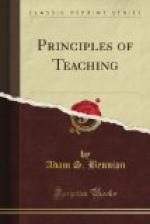The following questions on the expulsion of the Saints from Missouri are illustrative review questions:
1. To what extent, if any, were the Latter-day Saints themselves responsible for their expulsion from Missouri?
2. To what extent were the persecutions of Missouri political? Religious?
3. How do you account for the fact that the Lord’s people have always been a chastened people?
4. Show how the Missouri persecutions have been ultimately a blessing to the Latter-day Saints.
The second type of question is the fact question. It serves to check up on mental alertness and recall. It is often helpful in arresting attention and therefore has a certain disciplinary function. The teacher, of course, must make sure that his pupils are grasping the subject-matter presented, and the fact question serves admirably as a test of knowledge. It is usually a short question calling for a short answer, and therefore may be used in a rapid-fire way that stimulates thought. It is this type of question that is hurled so frequently at classes with the consequences pointed out in the quotation from Miss Stevens.
The same author lists as objections to the continued use of these rapid-fire questions the following bad features. They result in:
1. Nervous tension.
2. The teacher’s doing most of the work.
3. Emphasis upon memory and superficial judgment.
4. Little time for the art of expression.
5. Little attention to the needs of particular individuals in a class.
6. The class being made a place for displaying knowledge.
7. Little self-reliant, independent thinking.
As illustrative of the fact question may we set down the following:
Who was Joseph Smith?
What was his father’s name?
What was his mother’s name?
Where was he born?
How old was he when he received his first vision?
When did he receive the plates?
The challenging question and the leading question are closely enough allied that we may well discuss them together. They are both intended to provoke creative thinking. The leading question aims to capitalize on what is already in the pupil’s mind in getting him to go one step further to a conclusion we already have in mind. Instead of telling a class of young children that Joseph Smith prayed to the Lord for help in choosing the church to which he might best belong, we might proceed by saying that the Prophet had asked his father and mother—he had asked his best friends—he had talked with all the ministers he could find—he had read in all of the available books—now who can tell what else he could do? The chief merit of the leading question lies in the fact that it paves the way for the answer. It is particularly helpful in encouraging young and backward pupils. But is easily subject to abuse. So much so that its use is very largely restricted in law courts. It results too frequently in the teacher’s thinking for the pupil, and therefore ought to be used with care.




